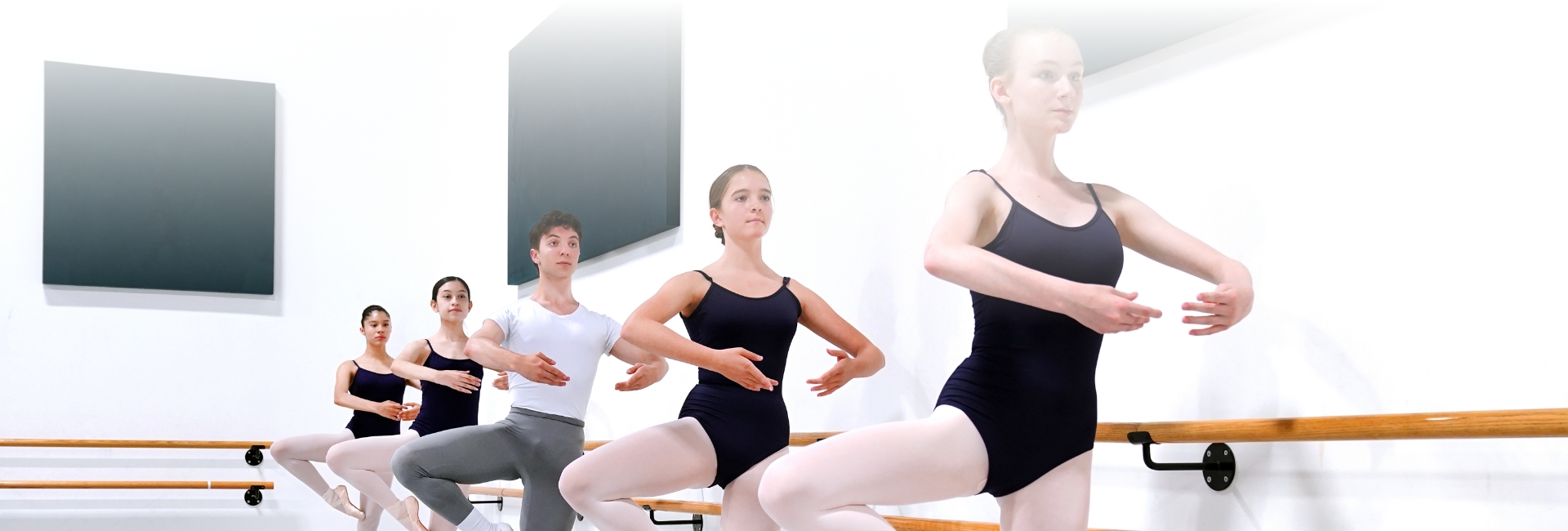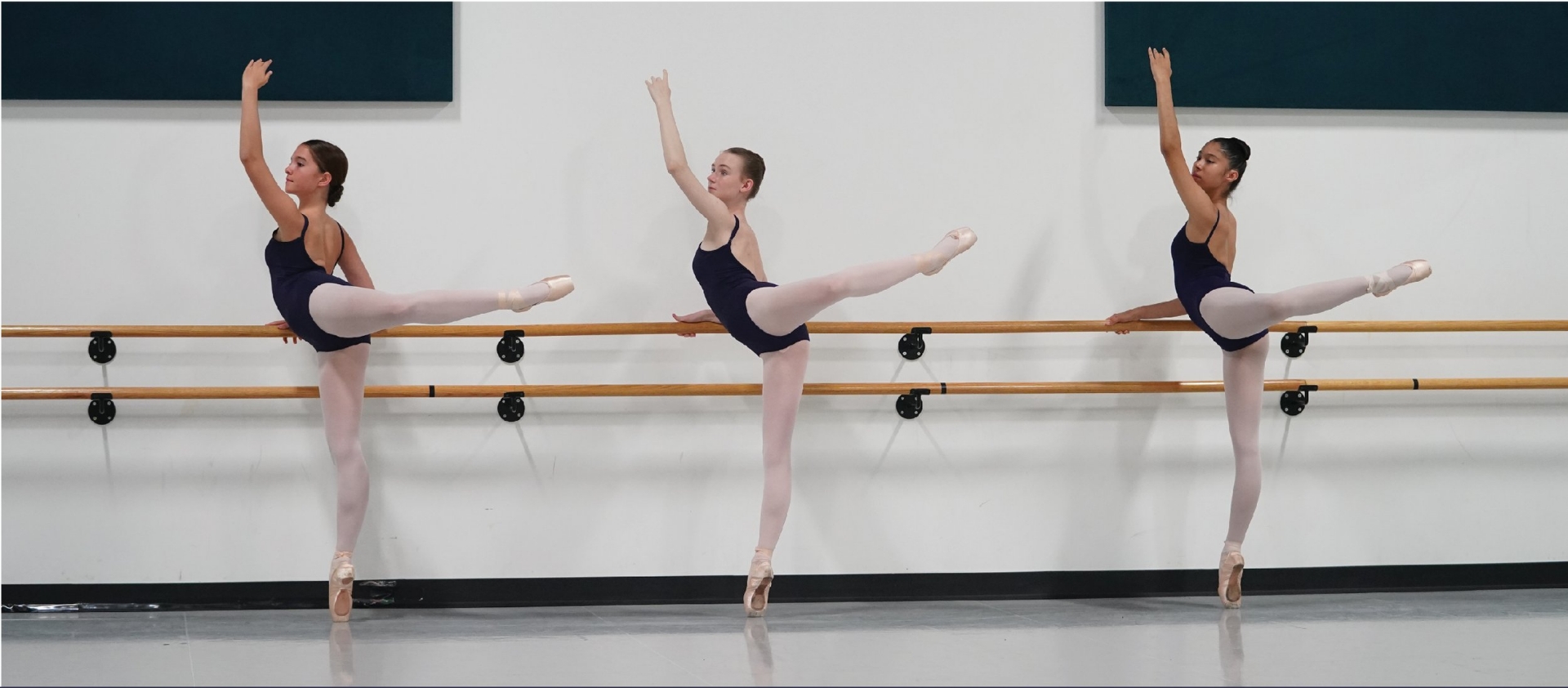
It is the policy of Eglevsky Ballet that students are promoted only when they have demonstrated a mastery of the material in their current level. Students are not automatically promoted after one year in a particular level, regardless of age. It is not uncommon for students to spend more than one year in any given level. Beginning in Ballet I, student ability, not age, determines class placement. Students missing more than 50% of their regular classes more than likely will not be promoted, as adequate time has not been spent mastering the work.
Students are placed in a level according to experience and ability, with the exception of students, age three, who will be placed in First Steps without further evaluation. Students, age four, will be placed in Pre-Primary without further evaluation. Students, age five, will be placed in Primary without further evaluation. Students, ages six and up without any experience will be evaluated and placed in an appropriate level. All other students are required to take a placement class. Placements are based on skill, technique, and physical strength. Placement is not based on age, and is at the sole discretion of Eglevsky Ballet faculty. If a student wishes to enroll mid-year, the guardians of the student must contact the office to schedule a placement class.
Classes at Eglevsky Ballet follow a progressively more rigorous path, beginning with young girls and boys in Level I and increasing in difficulty to our pre-professional programs. We also offer a two-year Professional Training Program for post-high school students, which allows students to study and apprentice with our professional company.
The Children’s Division enrolls 3-5 year-olds and prepares them for the study of ballet. The curriculum focuses on the basic elements of ballet technique while nurturing the discipline and cognitive skills focused ballet training demands. The Children’s Division at Eglevsky Ballet provides foundational skills in dance using techniques designed for the intellectual and physical development of our youngest students. Our inspired faculty offers progressive, non-competitive instruction allowing each young dancer to thrive in their love of movement and music. While introducing the basics of ballet, emphasis is placed on developing coordination, motor skills, musicality.
* First Steps (ages 3-4) is an introduction to the art of dance and music. Designed to encourage creativity, musicality and physicality, the classes develop basic coordination and enhance motor skills. Developing an awareness to music as well as listening activities are a large part of the curriculum.
* Pre-Primary (ages 4-5) begins the introduction of ballet and formative technique. A continuation of the material covered in First Steps but with a greater emphasis on beginnings of basic ballet. Your child will develop body awareness and control while exploring his or her own creativity to understand the connection between dance, rhythm, and music.
* Primary (ages 5-6) builds on lessons learned in previous classes with the goal of preparation to enter Level I in the graded syllabus. Concentration on ballet barre exercises (done in center), balance, connecting steps, memory retention skills, terminology, and musicality are an important part of the class.

* The Level I curriculum is designed to develop the dancer’s technique. The focus of this class will be to correct posture, increase flexibility, gain strength, and learn the vocabulary of ballet. This environment allows young dancers to gain confidence and build self-esteem in their developing technique.
* Level ll continues the fundamentals of classical ballet learned in Ballet I, but also challenges their concepts with more rigorous and advanced material. An emphasis is placed upon proper placement, alignment, musicality, clarity and execution of steps with controlled turnout.
* Level Ill delves further into classical ballet technique, vocabulary, and overall strength and stamina. Here we begin preparation for the demands of the curriculum of Levels IV & V. Because of the intensity of the work, most students will spend two years in Level III.
* Level IV students are working towards more difficult steps and intricate combinations. Once the student has learned basic technique and demonstrated a solid, mastery of foundational technique, pointe work begins. The ankles, legs, and feet (as well as the core) must be sufficiently developed. Because the readiness happens at different times for students, this determination is at the sole discretion of the Eglevsky Ballet faculty.
* Level V is the final level of study in the Lower School preparing the dancer for entry into the Pre-Professional Training levels in the Upper School. Students begin a more in-depth study of ballet and pointe and are expected to engage strength to show clear and precise technique while continuing to develop musicality. Both modern and jazz are added to their ballet training to enhance their classical ballet training.
Advancement between the Lower School and the Upper School is highly individualized to ensure students train at the appropriate level to facilitate maximum learning and growth. Promotions from these two divisions are made with great care, as Upper School students are expected to have a higher level of commitment. Students in Level V who have not sufficiently demonstrated strong potential may not be invited to continue in this pre-professional track. Mid-year conferences are scheduled with parents of Level V students to discuss potential impediments to progression. Final re-enrollment decisions are made in the spring.
The Pre-Professional Training Program was created to provide exceptional opportunities to our students who have sincere and dedicated wishes to become professional dancers. These students have shown the skill, desire, and commitment to the art to have a career in the dance arts. This program is by audition or invitation only and each dancer commits to a contracted year of study in this program.
An 85% attendance rate must be maintained as well as participation in all performances, outreach lecture demonstrations, and any other promotional activities of Eglevsky Ballet. This elite and talented group of young dancers experience an expanded schedule of technique classes, residencies by renown educators, and master classes. It is our goal to ensure each dancer is prepared for a place in an ever-changing dance world. To this end, additional coaching and private lessons are also given in addition to regular Academy classes.
* PTP I technique classes in this level increasingly emphasize classical technique shaped by Vaganova and French methods, as well as the Balanchine aesthetic. Students strive to increase control, precision, speed and musicality, and further develop the ability to learn combinations quickly and apply corrections as soon as they are given. Particular emphasis on petite allegro, batterie, multiple pirouettes, and grand allegro are a major part of the curriculum.
* PTP ll is a continuation of the work from PTP I with increased intensity and focus on stronger technique, speed, and musicality. Mastery of grand allegro and advanced steps are required for promotion.
PTP Ill is the most advanced level Eglevsky Ballet offers. Students at this level are expected to operate on the level of a first-year corps de ballet member of a professional company. The work includes an emphasis on technique as it applies to performance, more virtuosity in advanced technique, as well as continued development of style and mastery of
All students in the Pre-Professional Training Program are expected to perform in the Annual Student Workshop Performance.

While many of our students wish to pursue dance as a career, there are others who enjoy the study of dancing and desire to receive the best training available. The Academy Program allows our students to study dance at their level of commitment and skill in a non-competitive environment.
Just as in the Lower and Upper Schools, students progress here by ability. The expectations are the same; focused work with the intention of achieving their personal best. This will determine their progress and allow for promotion.
Youth Beginner I & II will be comprised of students who are studying only once per week. Students in Youth Intermediate I & II are also once per week students. Teen Intermediate/Advanced I & II have the opportunity to study three times per week.
All students in the Academy Program will have performance opportunities.